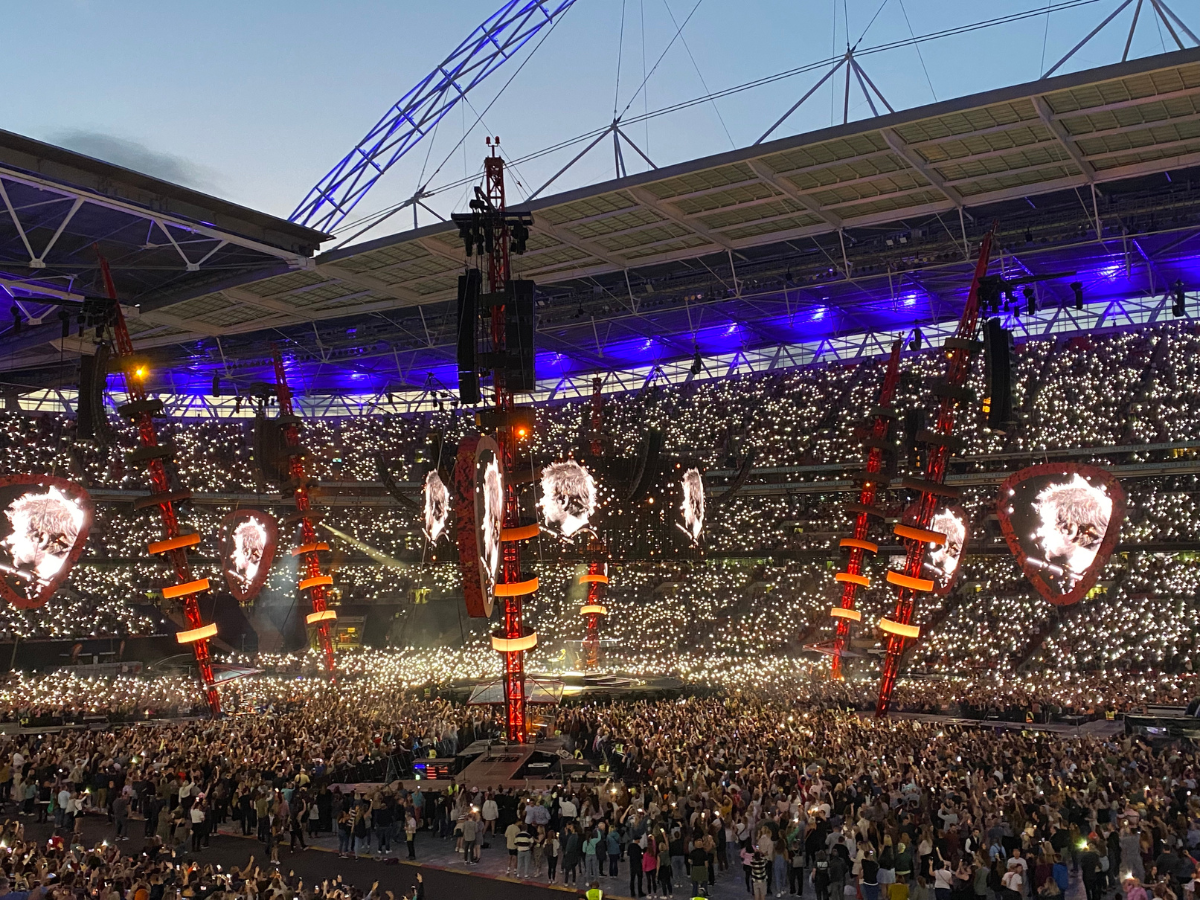Wembley Stadium is London’s biggest sporting and music venue. As one of our favourite places to see concerts in the summer months, we’re really excited to delve into the history of the stadium and give you our top tips and insider details about where to eat, drink, and sleep if you’re attending an event!
Table of Contents:
- History
- Seating Plan
- Football at Wembley Stadium
- Concerts at the Stadium
- How to Get to Wembley
- Entrances to the Stadium
- Where to Eat in Wembley
- Things to Know Before You Go
- Food & Drink Inside the Stadium
- Nearby Hotels
- Where is Wembley?
- Stadium Tours
History of Wembley Stadium
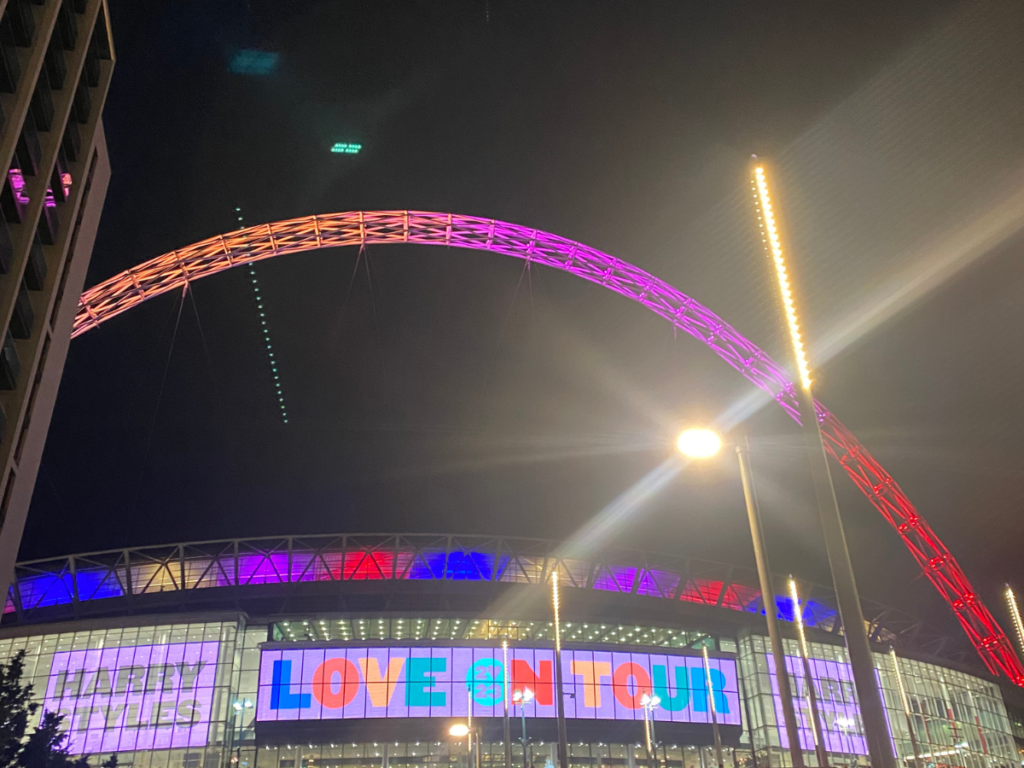
The original Wembley Stadium first opened in 1923, and housed the British Empire Exhibition of 1924-25. Whilst it was meant to be demolished soon afterwards, it went on to be home to the 1948 London Olympics, as well as seeing England’s 1966 World Cup win, before finally closing in 2000.
The stadium as we know it today started construction in 2002, before officially opening in 2007. With a giant arch, Wembley Stadium is instantly recognisable from any view in London. The stadium today is home to The Football Association Cup Final, as well as being used for the 2012 Olympic football matches.
Alongside its sporting accolades, Wembley has also become synonymous with live music. The most notable concert being the original Live Aid charity gig in 1985.
Seating Plan
Depending on whether you’re going to see the football, another sporting event, or a concert, the seating plan for Wembley Stadium may look different. In total the stadium’s capacity is 90,000, making it the largest in the UK.
For concerts an artist’s stage will impact which seats are available and which are obscured. The floor is typically standing at these events with barriers being used to split it into sections. This helps to control the crowds. Then seats within each tier will be used. Due to the circular format of the stadium, there really isn’t a bad seat in Wembley. We’ve stood, sat in the first tier of seats, and even almost right at the back in tier 5 and all the views have been great.
For sporting events, you won’t tend to get tickets for the floor as this is where the players will be. But the whole circle of seats will usually be available for purchase.
See the view from your seat before you get there on the Wembley Stadium site.
The Nation’s National Football Stadium
Wembley is a football stadium, and for most of the year this is the type of event that you’ll find on. In fact, Wembley Stadium is the national stadium for England’s football team. It has 90,000 seats so plenty of room for all of the fans!
Concerts at Wembley
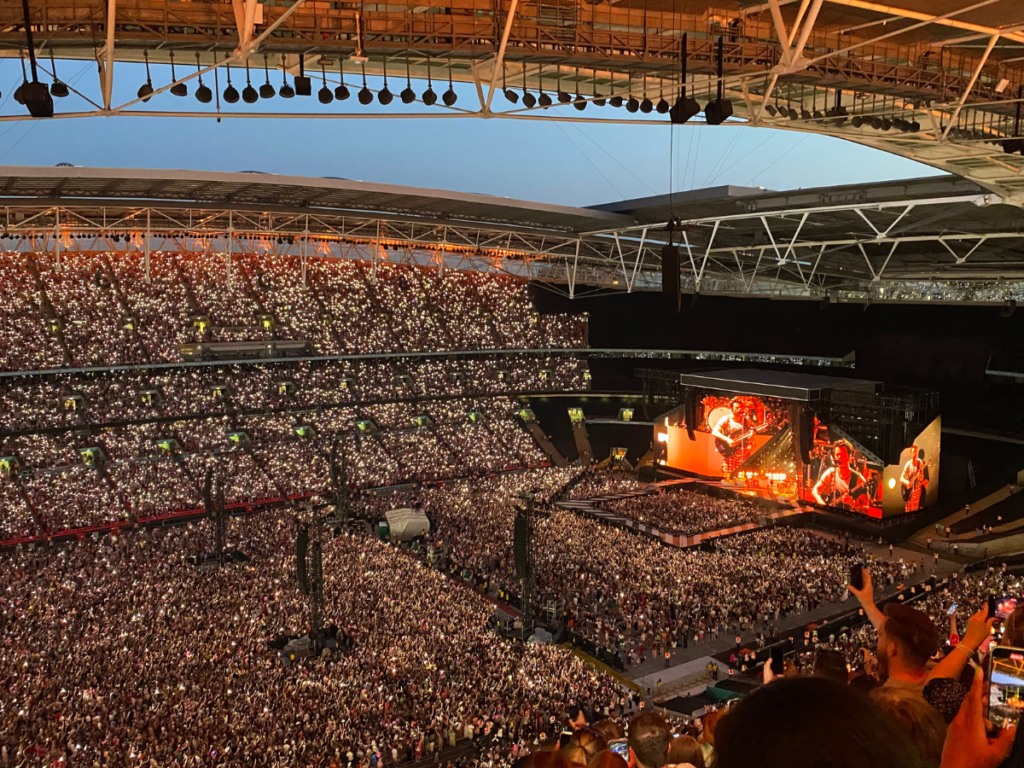
Summer in London brings warmer weather that allows the stadium to host concerts from the world’s biggest stars. Over the past few years the stadium has hosted Harry Styles’s Love on Tour, Ed Sheeran’s Mathematics tour, the annual Capital Summertime Ball and so much more.
2024 will see one of the most anticipated concerts to hit London to date: Taylor Swift’s The Eras Tour.
For those who don’t mind standing, you’ll enjoy a fabulous atmosphere down on the floor! If you’re able to, we’d definitely recommend doing pitch standing at least once in your life.
If like us, you’ve reached a stage where you like having a seat and knowing you’ll have an unblocked view – we’d recommend trying to get tickets in the first tier. However, even right at the back of tier 5 has a great view and atmosphere.
How to Get to Wembley Stadium
Wembley Stadium, whilst in an awkward part of London to get to, is served by lots of different transport options. Take your pick from those below.
By Train:
For those wishing to arrive by train, the closest station is Wembley Stadium Station which has direct trains to and from London Marylebone. There are clear signs once you get here to the venue.
By Tube:
The stadium is served by two nearby tube stations: Wembley Park Station (Jubilee and Metropolitan lines) and Wembley Central Station (Bakerloo line). Both are within short walking distance perfect for event days. The queue out of the stadium to Wembley Park Station can take a few hours after an event finishes so do be warned that you won’t be on a tube right away unless you’re first to leave.
If you’re unfamiliar with London’s tube system, check out our guide on how to use the London underground before you travel.
By Bus:
Lots of bus routes run toWembley Stadium. Several bus stops are located in close proximity to the stadium, allowing fans to arrive conveniently via London bus. Detailed route information and schedules can be obtained from Transport for London (TfL).
By Car:
The first thing to let you know if you plan on driving and parking at Wembley Stadium, is that it won’t save you any time when leaving the venue. We’ve sat in the carpark for two hours waiting to get out at previous gigs.
If however, you don’t mind this and still want to bring your car Wembley Stadium is easily accessible via the North Circular Road (A406) and the A40. The stadium is well signposted from these routes and you’ll find a large car park once you’re here. However, it’s important to note that parking availability may vary depending on event days, so it’s advisable to check in advance and plan accordingly.
For those holding a blue badge, the parking is available to book in advance.
Entrances to Wembley Stadium
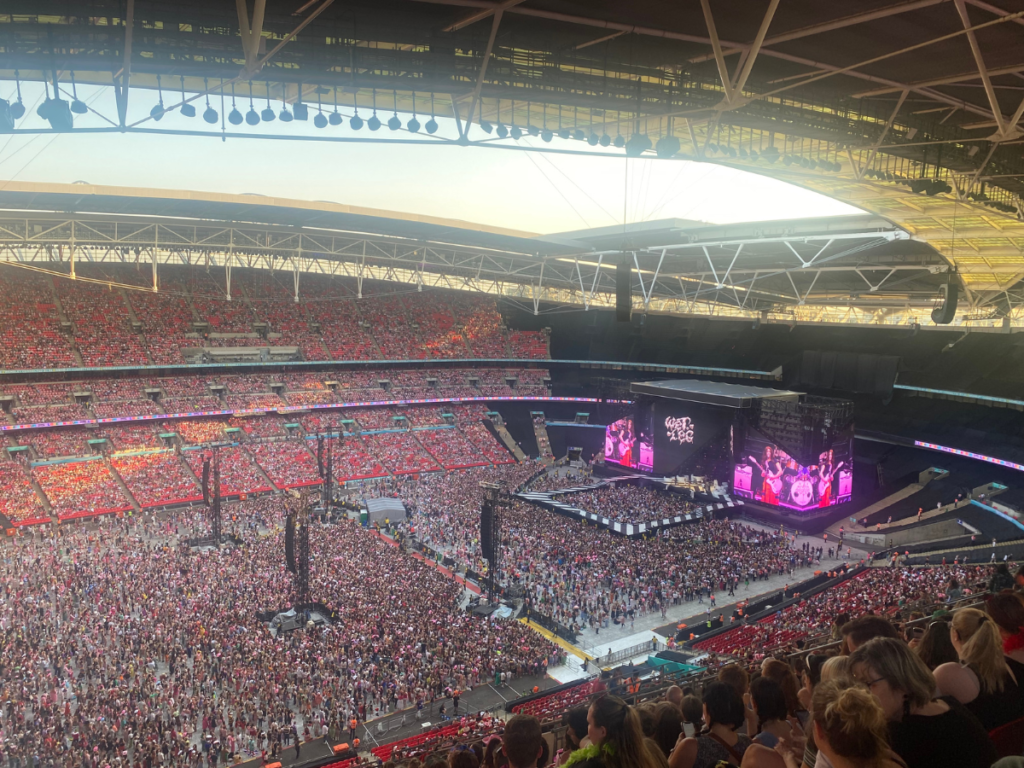
The stadium has multiple entrances around the outside of the venue. Your tickets to your event should tell you which entrance to use.
They are broken up into colour blocks: green, blue, red, and yellow. Followed by lettered entrances. There are clear signs once you get up to the stadium as to where each colour section is located.
Where to Eat
Wanting to grab some food before your event? Well you’re in luck, the area around Wembley Stadium has seen lots of new development in recent years that has brought many more restaurants and cafes to the area.
On your approach from Wembley Park tube station, you’ll see Box Park Wembley which has 20 vendors for food, as well as bars to grab a drink before you go into the venue. From sushi to thai, acai bowls to pizza, there’s something for everyone here.
Things to Know Before You Go
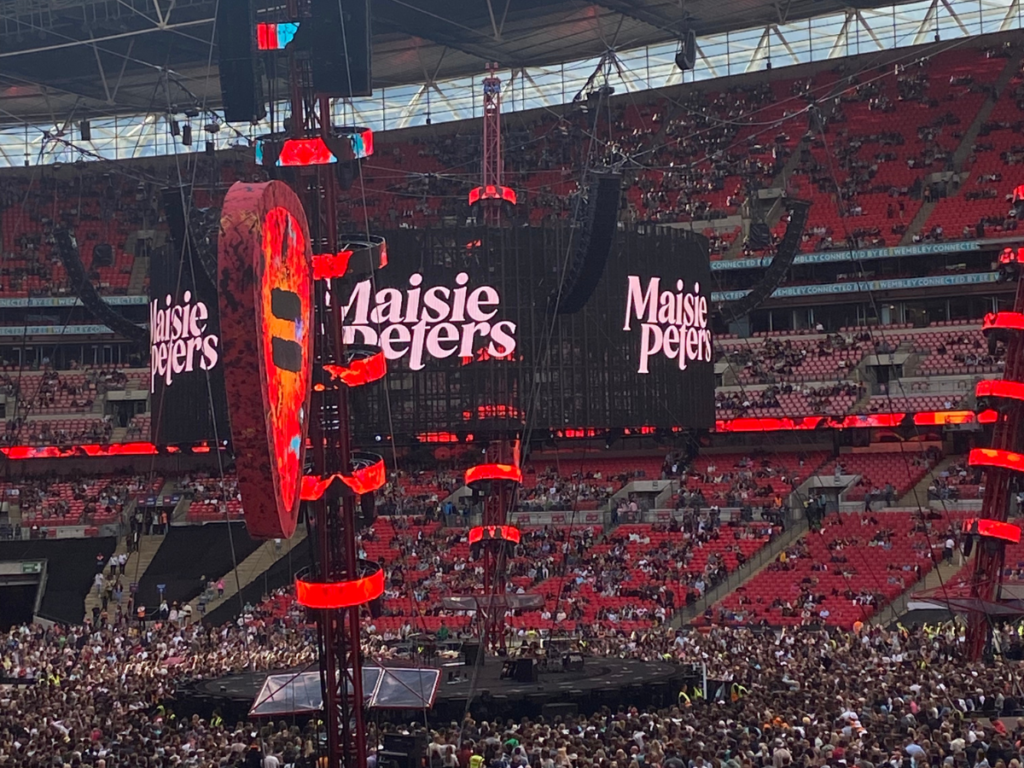
There’s a few things to know before you go to Wembley to make sure you have the best experience possible on your trip. Here are a few tips from us:
- Make sure your bag is within the bag policy – You can find Wembley’s bag policy on their website, it lets you know what size you can take in with you.
- Prohibited items – as with all London venues, there are some items you cannot bring in with you. See Wembley’s prohibited items here.
- Take an empty 500ml bottle – you cannot take in food and drink to the stadium but you can take in a small empty bottle. There are refill points within the stadium.
- Particularly if you’re standing at a concert we’d highly recommend doing this to ensure you have water throughout the show.
- Leaving the stadium takes a while – Be prepared for a long wait for the tube, especially if you’re in one of the top tiers where it takes longer to get out.
What is There to Eat & Drink in the Stadium
There are plenty of places within the stadium to purchase food and drink, with vendors around the whole of each individual floor. From cocktail bars and burger vendors, to sweets, popcorn, and draught bars. The food and drink is obviously priced at a premium as you’re a captive audience within the stadium, but from our personal experience it does tend to be of good quality.
You can find information on the vendors on Wembley Stadium’s website.
Nearby Hotels to Stay in
If you’re not a local and are looking for a place to book after your event at Wembley, you’re in luck as there are plenty of local hotels. Here are just a few of the well-known hotel brands that are located around the stadium (conveniently for a short walk straight to bed after your night of celebration):
Where is Wembley?
Wembley Stadium is located in North-West London, 10 miles from Central London.
Stadium Tours
Big football fan? With official tours of the Stadium you can experience the areas of the venue not usually open to the public. The stadium offers different types of tours from the full stadium on non-match/event days, to matchday tours, and VIP tours that take you to even more exclusive areas of the building.
About The London Eats List
We’re here to help guide your next trip to London. From guides to each season: summer, autumn, winter, and spring. To the best London restaurants with views of the city – get inspired now.

